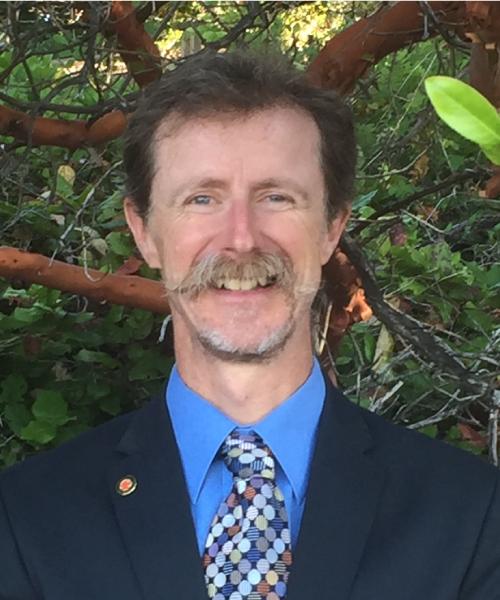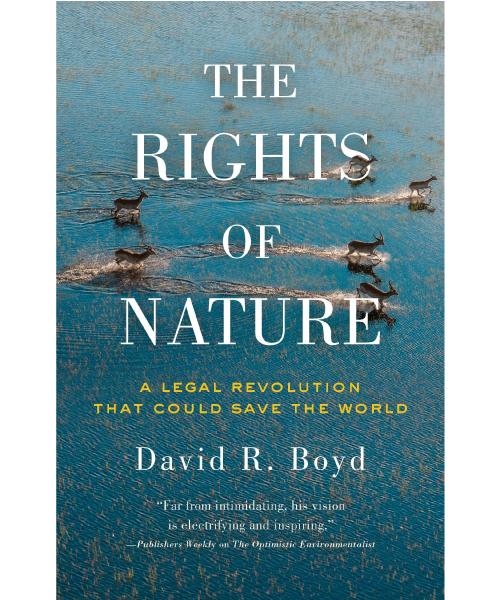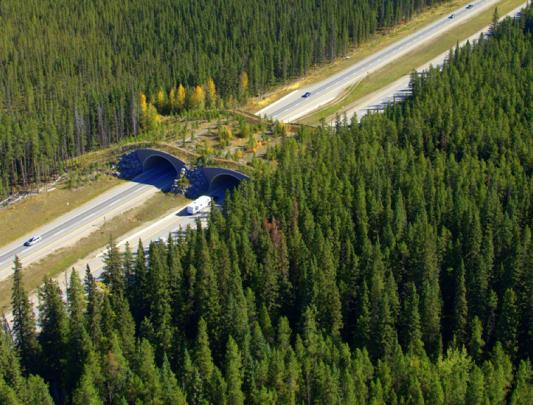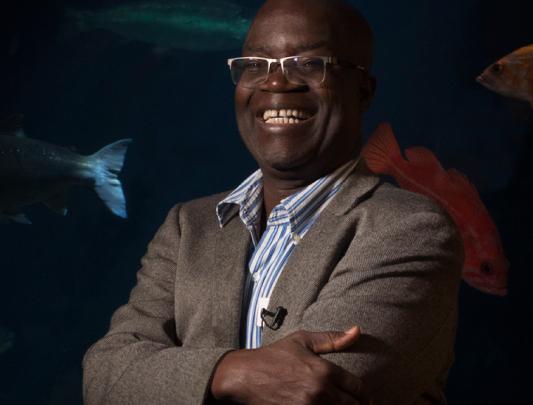Opinion
“It is time for Canadians to embrace the rights of nature.”
David Boyd, PhD’10, points out that other countries have already recognized the legal rights of non-human animals, endangered species, and ecosystems.
Can you imagine a world without southern resident killer whales, mountain caribou, elephants, giraffes, cheetahs, tigers, leopards, rhinos, gorillas, and orangutans? Or a world where these magnificent animals survive only in zoos and aquariums, as faint, caged shadows of their wild selves?
Most people would be horrified by such nightmarish scenarios. Yet despite decades of dedicated conservation efforts, that is where we are headed. The World Wildlife Fund’s Living Planet Index, which monitors over 3,700 vertebrate species, reports an average population decline of roughly 60 per cent since 1970. A 2017 article published in the Proceedings of the National Academy of Sciences crunched the data on thousands of populations of mammals and concluded we are in the midst of a “biological annihilation.” A 2019 report by hundreds of scientists with the Intergovernmental Policy Platform on Biodiversity and Ecosystem Services (IPBES) warned that a million species are at risk of extinction due to human activities.
In response to the global biodiversity crisis and changes in the way we view other living entities, a radical idea is gaining traction around the world. Laws and cultures are changing to recognize that animals, species, and even nature itself – rivers, coral reefs, mountains, and ecosystems – have rights. Rights have the power to modify our beliefs and behaviour in profound ways, as abolitionists, suffragettes and Indigenous people can attest.
Just a few years ago, suggesting that non‑human animals or ecosystems ought to have legal rights might have provoked puzzled looks or even ridicule. The idea is no longer funny or far‑fetched. Scientific discoveries sparked by Jane Goodall’s work with chimpanzees have obliterated old theories about animals as automatons. Not only our closest relatives, the great apes, are complex, emotional, sentient creatures. Researchers have also discovered amazing capabilities in species from ants to elephants, octopuses to ravens. New discoveries reveal the remarkable communications and networking among trees and other types of plants.
Scientists agree that everything is connected. Humans are related to all other forms of life and are composed of the same elements as mountains and rivers. As British physicist Brian Cox wrote in his book Forces of Nature, “there is no fundamental difference between inanimate things, such as planets, and living things such as bacteria and human beings; all objects in the Universe are made of the same ingredients” and shaped by the same laws of nature.
In recent years there have been revolutionary breakthroughs across the world as governments, communities, and courts have recognized the legal rights of non‑human animals, endangered species, and ecosystems. Among the beneficiaries so far have been chimpanzees, orangutans, spectacled bears, Asiatic lions, rivers, lakes, forests and, in Bolivia and Ecuador, Mother Nature herself.
One of the first breakthroughs came in 2006, in an unlikely place. Citizens of Tamaqua Borough, a small community in rural Pennsylvania, were deeply concerned about a proposal to spread urban sewage sludge on farmland. After regular environmental laws failed, they enacted a pioneering municipal bylaw that recognized the rights of nature. Since then, in response to environmental threats such as fracking, more than three dozen American communities – from Santa Monica, California, to Pittsburgh, Pennsylvania – have enacted bylaws elevating nature’s rights above corporate rights in an effort to protect both human and ecosystem health.
In 2008, Ecuador passed the first Constitution to include the rights of Pachamama, or Mother Earth. Since then Ecuador has revised more than 70 laws and policies to incorporate nature’s rights. Ecuador’s courts have begun interpreting these rights, including the first case in the world where a judge ruled that nature’s constitutional rights had been violated. The Vilcabamba River had been damaged by highway construction, and a court ordered the government to carry out restoration activities.
In 2010 Bolivia passed a law called Law on the Rights of Mother Earth. Bolivia also sparked a global movement to establish a Universal Declaration for the Rights of Mother Earth.
New Zealand is a world leader in recognizing the rights of nature, sparked by the efforts of the Maori. Like Canada, New Zealand is striving to achieve reconciliation with Indigenous peoples. Te Urewera National Park was created in the 1950s on land that had been illegally taken from the Maori over the course of the previous century. The Maori had consistently pressed for recognition of their relationship to this region, expressed as rangatiratanga [authority], whanaungatanga [kinship], and kaitiakitanga [stewardship].
In 2014, New Zealand passed a revolutionary law that changed the status of Te Urewera National Park to that of a legal person with a variety of rights. Those rights involve maintaining Te Urewera’s biodiversity, ecological systems, and cultural heritage in perpetuity. The law empowers a guardian to defend the ecosystem’s rights. Most remarkably, title to 200,000 hectares was transferred from the government to the newly created legal person. In other words, the land now owns itself. From a western legal perspective, this is mindboggling. As Dr. Nick Smith, the Minister for Environment, said, “If you’d told me 15 years ago that Parliament would almost unanimously be able to agree to this, I would have said, ‘You’re dreaming, mate.’”
Negotiations between the Crown and the Maori produced a second ground‑breaking law in 2017 recognizing the Whanganui River as a legal person, with a range of rights. The law defines the river in Maori terms as comprising both the physical and metaphysical elements of the watershed, and transferred the Crown’s title in the riverbed to the river itself. In 2018, the Maori and the government agreed to designate Mount Taranaki as a legal person, with the same rights and protections as the Whanganui River and Te Urewera.
In today’s interconnected world, ideas can travel with startling speed. Colombia’s Constitutional Court ordered the government to recognize the rights of the Atrato River and create a guardian based on the New Zealand model. Columbia’s Supreme Court extended rights to the Amazon rainforest. A court in India ruled that the Ganges and Yamuna Rivers have rights, and later clarified that these rights extend to all natural entities in these watersheds, from glaciers and waterfalls to forests and meadows. A court in Bangladesh made a similar ruling. Laws recognizing the rights of nature have been enacted in Mexico and Uganda.
Many Indigenous people in Canada possess a worldview, concisely summarized in the phrase “all my relations,” which goes beyond aunts and cousins to include ravens, killer whales, water, rocks, and more. In his outstanding book Canada’s Indigenous Constitution, Professor John Borrows indicates that nature’s rights are an integral component of many First Nations’ legal systems.
Some Canadians, and lawyers in particular, may struggle with the concept of granting rights to an ecosystem or a river. And yet it is far from unusual in our legal system to extend rights to non‑human entities. For example, corporations are designated by the law as legal persons and enjoy a wide range of rights.
It is time for Canadians to embrace the rights of nature. This innovative approach would enable all of us to reflect on our relationship with the place we call home. Recognizing that nature has rights could help us transcend the destructive and misconceived perception that humans are separate from our environment and inherently superior to all other creatures. The air, water, soil, plants, wildlife and even the spirit of this incredible country make us who we are, and sustain us physically, mentally, and emotionally. We have to finally understand, as conservationist Aldo Leopold wrote, that nature is not a commodity that we own, but a community to which we belong.
The diversity of life on Earth is one of the most extraordinary wonders in the universe. Facing a global biodiversity emergency of our own making, we must acknowledge the incalculable value of what we are losing, and respond with unprecedented and heroic measures.
David R. Boyd is an associate professor in law, policy and sustainability who is jointly appointed at UBC’s Institute for Resources, Environment and Sustainability and its School of Public Policy and GLobal Affairs. He is the author of The Rights of Nature: A Legal Revolution that Could Save the World (ECW Press, 2017), and is currently serving as the United Nations Special Rapporteur on human rights and the environment.






































